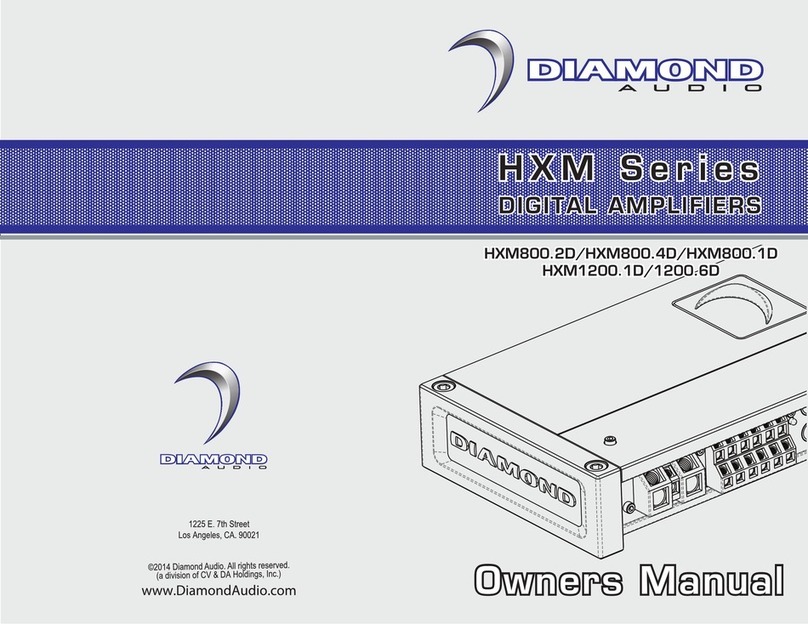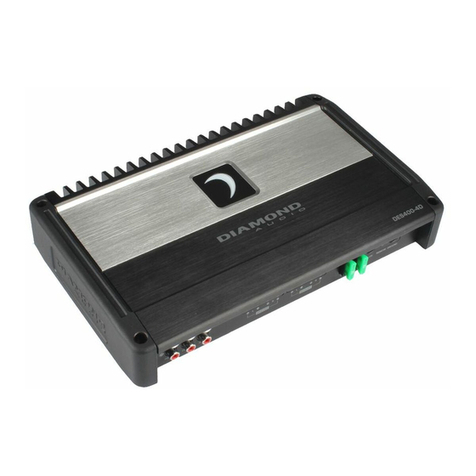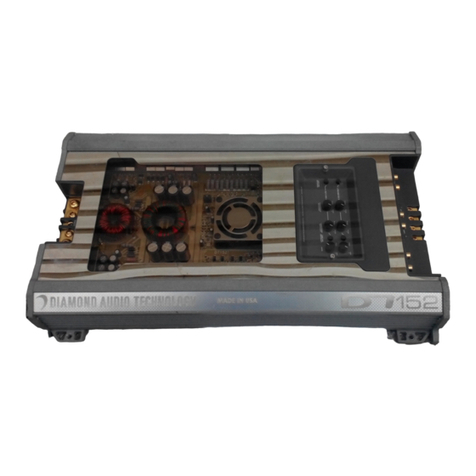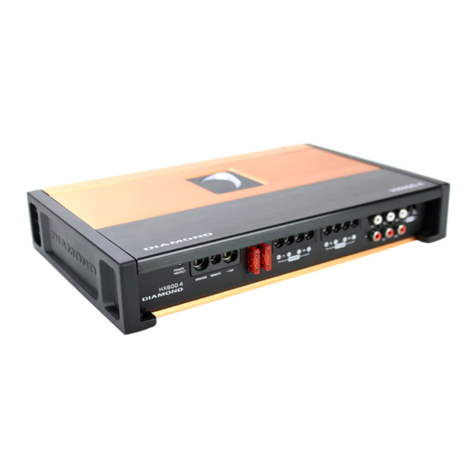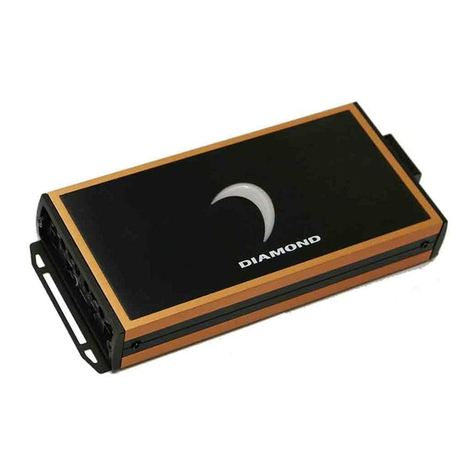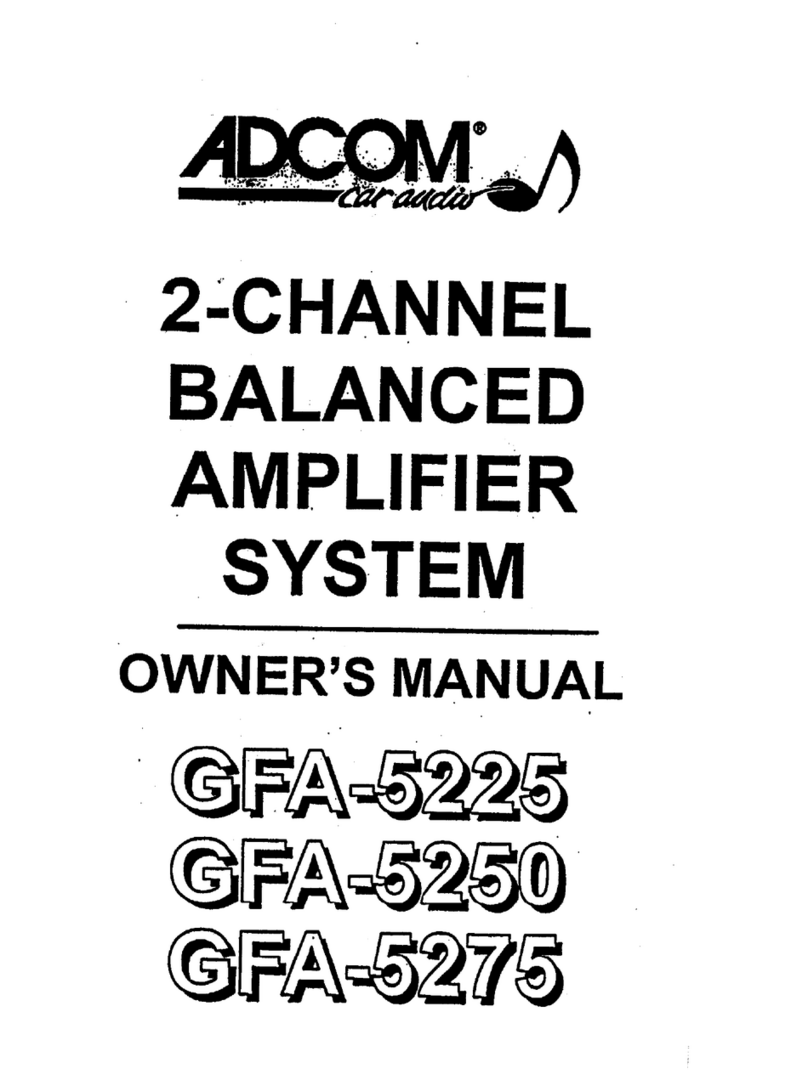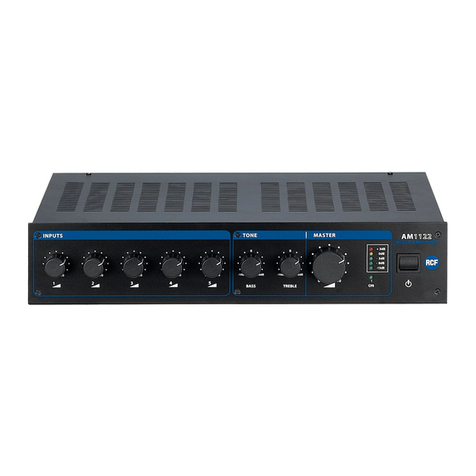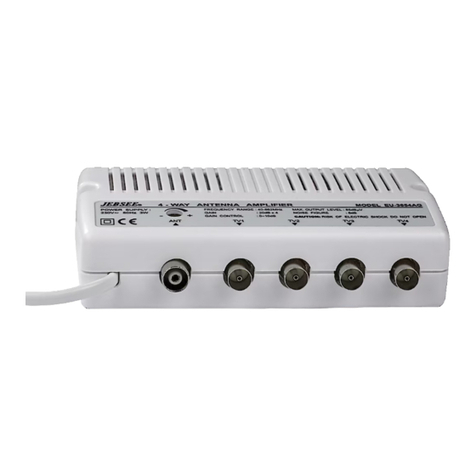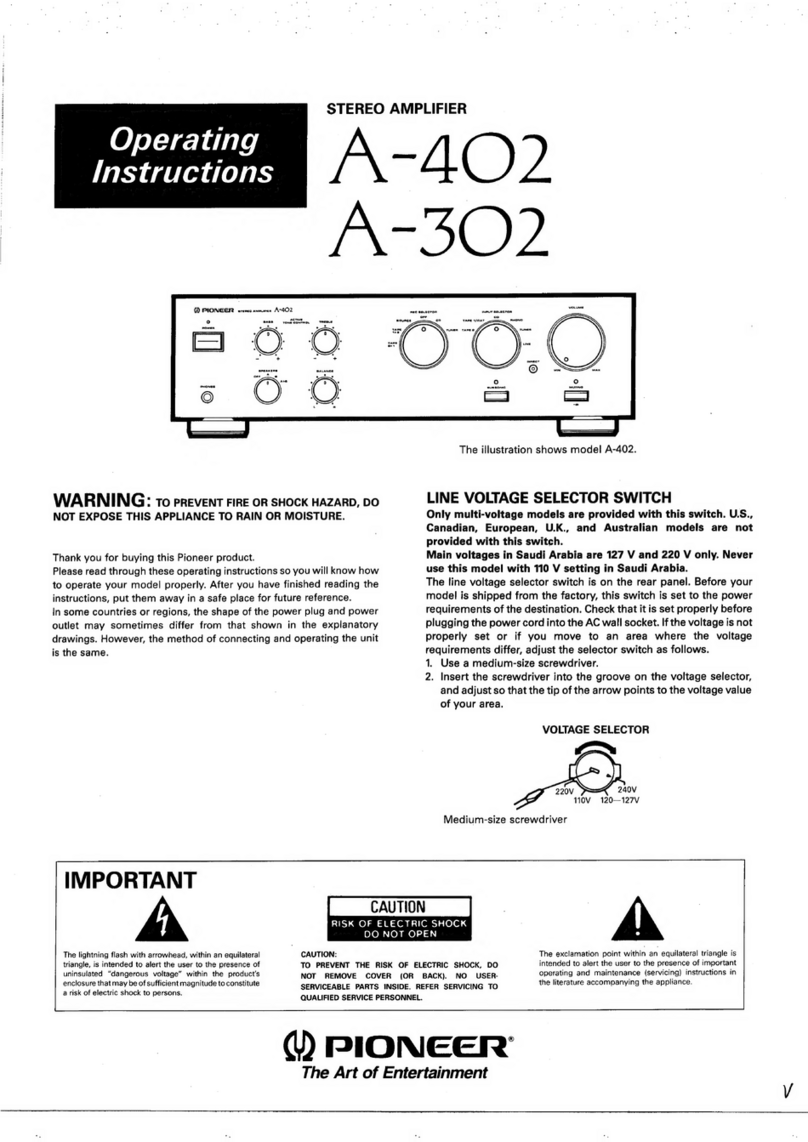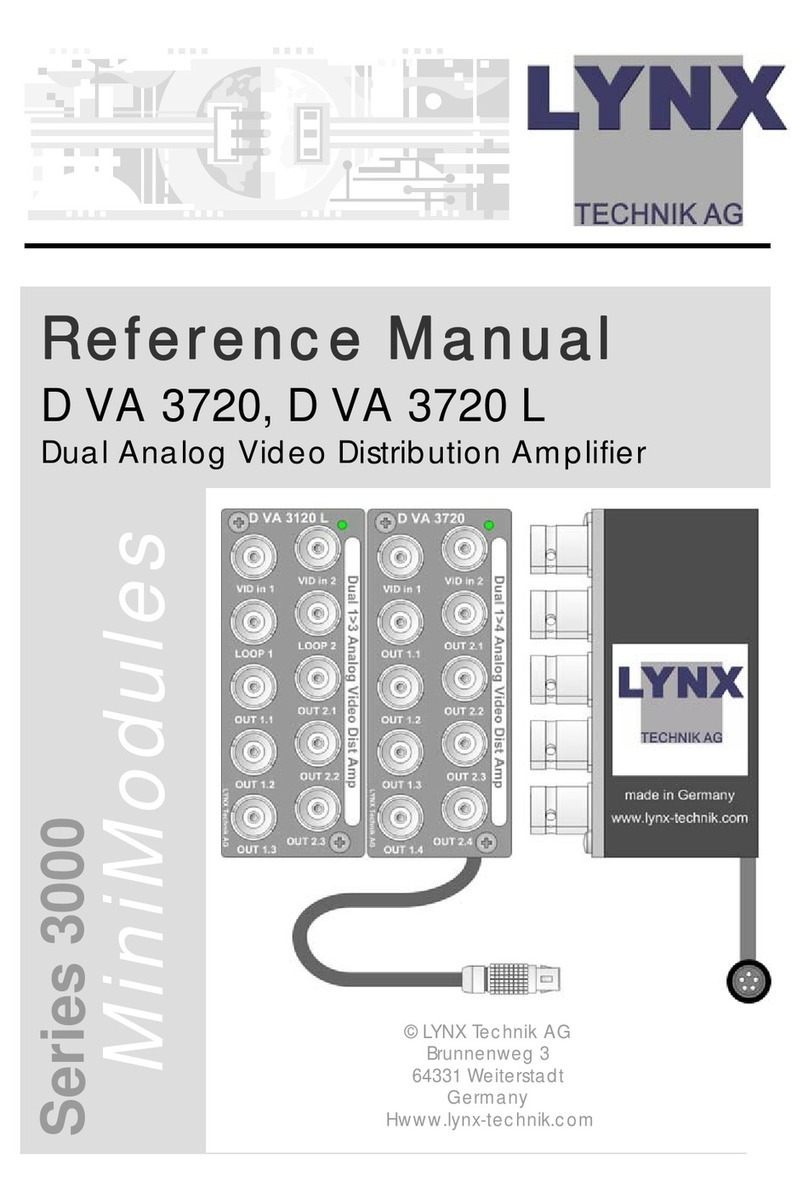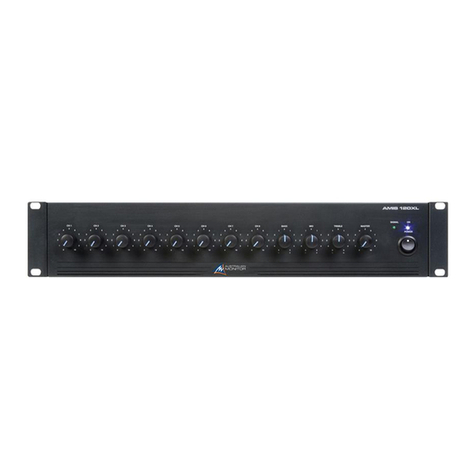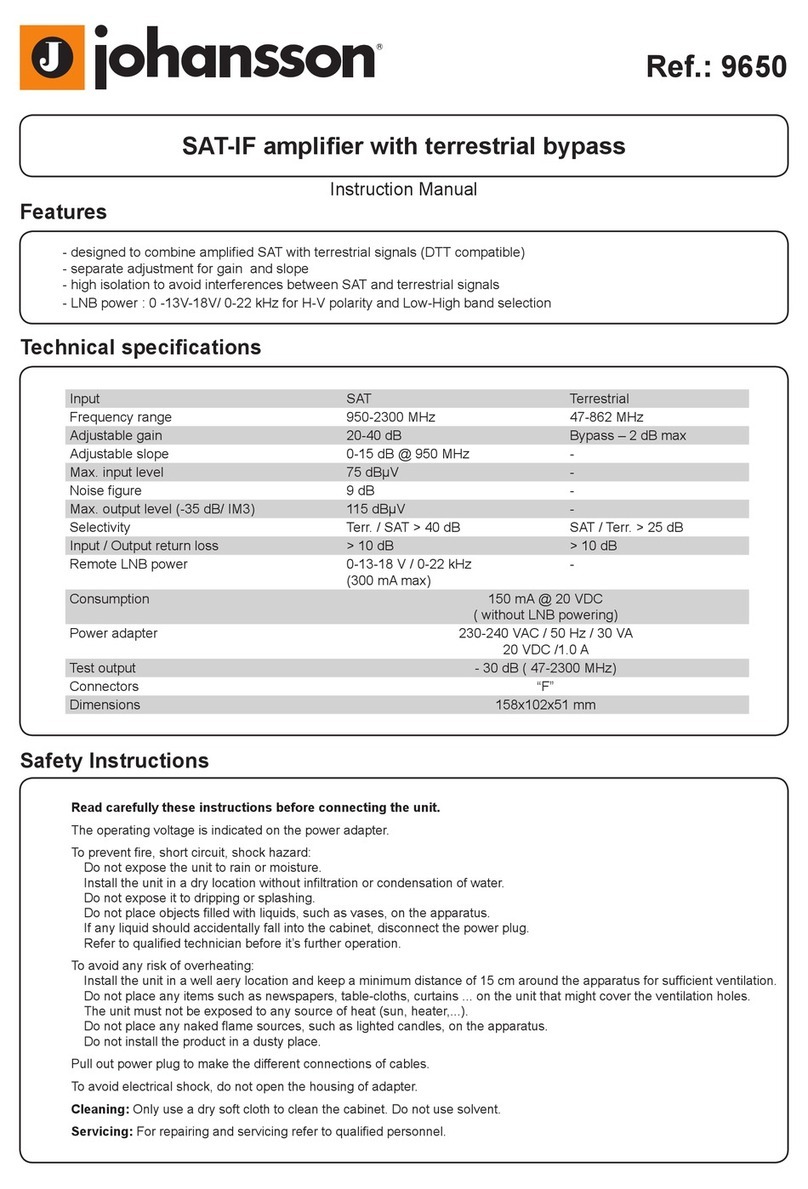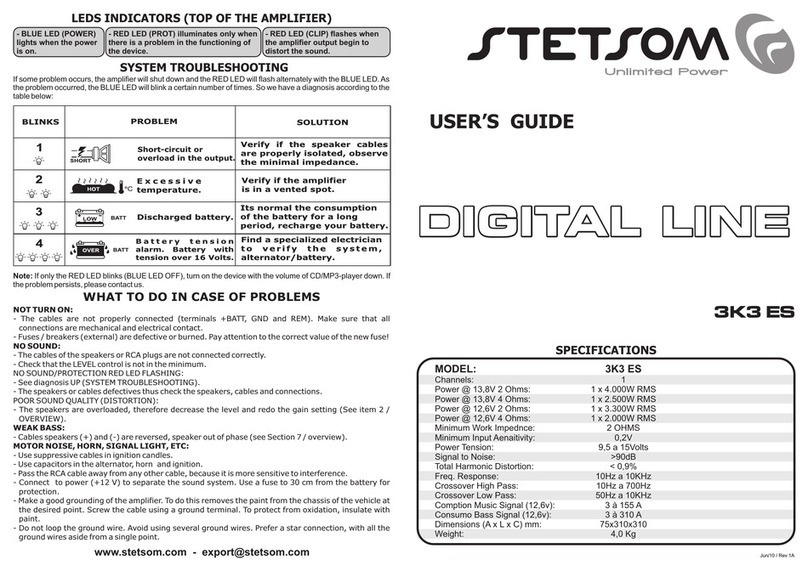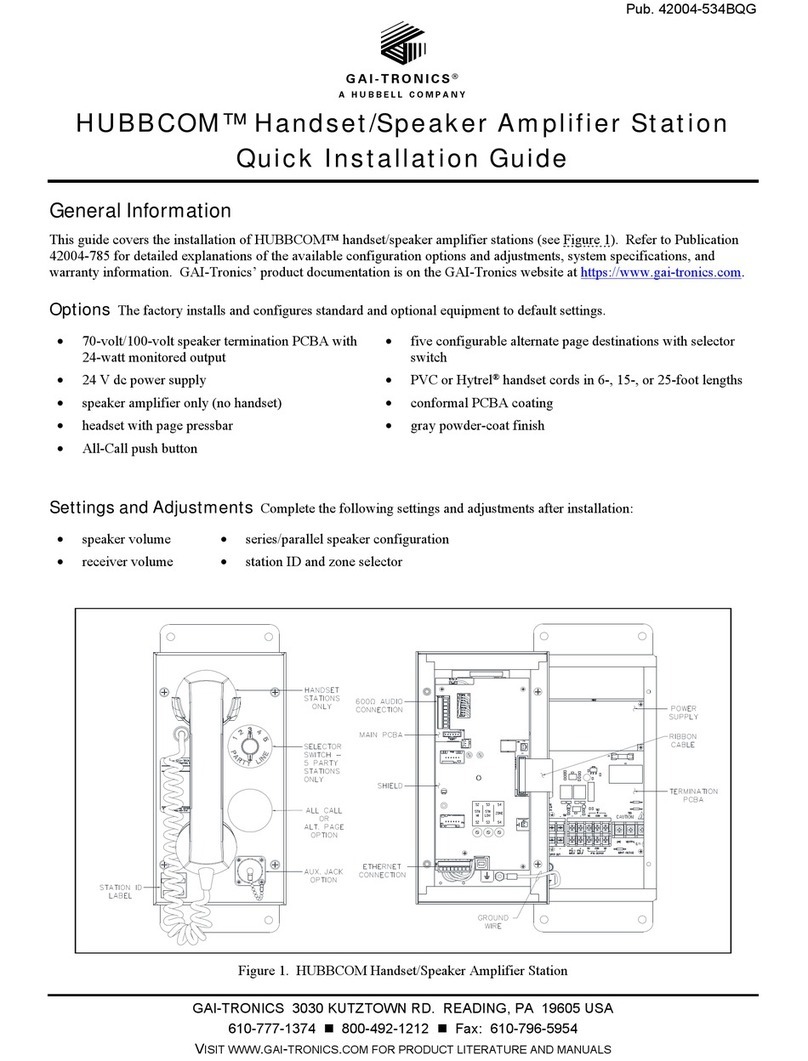Diamond Audio D300.2 User manual

DIA.IVIOND
AMPLIFIER
INSTALLATION
MANUAL
.
o3oo.2
I
o3oo.4
I
o6oo.4
o4oo.1
I
o6oo.1
I
o1ooo.1

Congratulations!
Thank
you
for
choosing
a
new
Diamond
Audio
amplifier.
Diamond
Audio
amplifiers
are
engineered
and
produced
with
the
highest
quality
materi-
als
and
incorporate
the
latest
technology.
We
think
you
will
find
your
new
Diamond
Audio
amplifier
meets
or
exceeds
your
expectations
and
provides
excellent
value.
Properly
installed,
your
new
Diamond
Audio
amplifier
will
provide
years
of
high
quality
sonic
reproduction.
Before
installing
the
amplifier
in
your
vehicle,
please
read
this
entire
manual
carefully.
It
is
required
reading
for
the
protection
of
your
vehicle
and
for
the
maximum
performance
of
your
mobile
audio
system.
All
Diamond
Audio
amplifiers
have
been
extensively
tested
and
"burned-in"
for
maximum
reliability.
If
after
reading
this
manual,
you
still
have
questions
regarding
this
product.
we
recommend
that
you
contact
your
authorized
Diamond
Audio
dealer
for
expert
installation
assistance.
If
you
need
assistance
with
repair
or
warranty,
detailed
warranty
and
return/repair
information
is
listed
in
the
back
of
this
manual.
Be
sure
you
record
your
serial
number,
model
number
and
date
of
purchase
for
your
amplifier
as
this
will
be
necessary
for
any
returns.
Please
Practice
Safe
Sound!
Continuous
exposure
to
sound
pressure
levels
over
100
dB
may
cause
permanent
hearing
loss.
High
powered
mobile
audio
systems
may
produce
sound
pressure
levels
well
over
130dB.
Use
common
sense
and
practice
safe
sound.
2
All
DiamondAmplifiers Feature:
• Pulse Width Modulated (PWM) MOSFET
Switching
Power Supply
• Up to
12
dB Bass Boost
• Extruded
Aluminum
Heatsink
•Nickel
Plated
RCA
Low
Level Audio
Inputs
•Nickel
plated,
low
resistance
power
and
speaker
connector
blocks
•
Power
ON
and Protection LED
Lighting
for
Easy Diagnostics
•
Thermal,
Short
Circuit, and Overload (Low Impedance) Protection
• Chassis
mounted
ATC/ATO type
automotive
fuses (except
D1
000.1)
• Proudly Designed and Engineered in
the
USA
0300.2
I0300.1, I0600.1, Features
•Class
AB
Amplifier
Topology
• Stable into 2 ohm Stereo Loads
•
lnternal12dB/Octave
Variable High Pass
or
Low
Pass
Filter
•
Hi-level
inputs
on D300.2 and D300.4
•
Pass-
Thru Line Output
for
Daisy Chaining
Amplifiers
•
Bridgeable
Output
Capability
[4ohms)
01,00.1 I
0600.1101000.1
Features
•Class
D
Amplifier
Topology (Class AB on D400.1)
•Stable
into 1 Ohm
(2
Ohm on D400.1)
•
Internal
24dB/Octave Variable
Low
Pass
Filter
(12dB
on
D400.1)
•
Hi-level
inputs
on D400.1
• Pass -Thru Line Output
for
Daisy Chaining
Amplifiers
• Remote Level
Control
• D600.1 and
D1
000.1 are Sync capable
• Subsonic
Filter
• 0°
or
180° Phase
Control

Frequency Response:
Signal to Noise Ratio:
Channel Separation
THD+N[Total Harmonic Distortion+ Noise)
RCA
Input Sensitivity:
Min
to
Max
Voltage requirements
High/Low
Pass
Crossover:
Crossover Configuration:
Dimensions
Frequency Response:
Signal to Noise Ratio:
Channel Separation
THD+N[Total Harmonic Distortion+ Noise)
RCA
Input Sensitivity:
Min to
Max
Voltage requirements
High/Low
Pass
Crossover:
Crossover Configuration:
Bass
EQ
Dimensions
Frequency Response:
Signal to Noise Ratio:
THD+N[Total Harmonic Distortion+ Noise)
RCA
Input Sensitivity:
Min to
Max
Voltage requirements
High/Low
Pass
Crossover:
Crossover Configuration:
Bass
EQ
Dimensions
Frequency Response:
Signal to Noise Ratio:
THD+N[Total Harmonic Distortion+ Noise)
RCA
Input Sensitivity:
Min
to
Max
Voltage requirements
Low
Pass
Crossover:
Crossover Configuration:
Bass
EQ
Dimensions
Frequency Response:
Signal to
No
i
se
Ratio:
Channel Separation
THD+N[Total Harmonic Distortion+ Noise)
RCA
Input Sensitivity:
Min
to
Max
Voltage requirements
High/Low
Pass
Crossover:
Crossover Configuration:
Bass
EQ
Dimensions
Frequency Response:
Signal to Noise Ratio:
THD+N[Total Harmonic Distortion+ Noise)
RCA
Input Sensitivity:
Min
to
Max
Voltage requirements
Low
Pass
Crossover:
Crossover Configuration:
Bass
EQ
Dimensions
20Hz
to
20KHz
+/-1
dB
>90dBA
[20
to 20kHz)
60dB
<0
.02%[0utput-1W 4 Ohms)
150mV
to
5V
9V
to
15.5V
DC
12dB/Oct
Variable
From
50-250Hz
Switchable [OFF/H P/LPI
[LJ11
.
1"
X
[WI
8.7" X
[HI
2.
25"
20Hz
to
20KHz
+/-1
dB
>90dBA
[20
to 20kHz)
60dB
<0.02
%[0utput-
1W
4 Ohms)
150mV to
5V
9V
to
15
.
5V
DC
12dB/Oct
Variable
From
50-250Hz
Switchable [OFF/HP/LPI
0
to+
12dB@
50Hz
[Variable)
[LJ13.4"
X
[WI
8.7"
X
[HI
2.
25"
20Hz
to
20KHz
+/-1
dB
>80dBA
[20
to 20kHz)
<0.05%[0utput-1W 4 Ohms)
150mV to
5V
9V
to
15.5V
DC
12dB/Oct
Variable
From
50-250Hz
Switchable [OFF/HP/LPI
0
to+
12dB@
50Hz
[Variable)
[LJ13.
4"
X
[WI
8.
7"
X
[HI
2.
25"
20Hz
to
20KHz
+/-1
dB
>90dBA
[20
to 20kHz)
<0
.
01
%[0utput-1W 4 Ohms)
150mV to
5V
9V
to
15.5V
DC
24dB/Oct
Variable
From
50-250Hz
[LP
Only)
0
to+
12dB
From
3D-125Hz
[Variable)
[L]13.7"
X
[WI
8.7"
X
[H)
2.
25"
20Hz
to
20KHz
+/-1
dB
>90dBA
[20
to 20kHz)
90dB
<0
.02%[0utput-1W 4 Ohms)
150mV to
5V
9V
to
15
.
5V
DC
12dB/Oct
Variable
From
50-250Hz
Switchable [OFF/HP/LPI
0
to+
12dB@
50Hz
[Variable)
[LJ17.1"
X
[WI
8.7"
X
[HI
2.25"
20Hz
to
250Hz
+/-1
dB
>90dBA
[20
to
20kHz)
<0.01
%[0utput-1W 4 Ohms)
150mV
to
5V
9V
to
15
.
5V
DC
24dB/Oct,
Variable
From
50-250Hz
[LP
Only)
Oto+12dB
From
3D-125Hz
[Variable)
[L]16"
X
[WI
8.7" X [HI 2.25"
0300.2
2-Channel
Amplifier
300
Watts
RMS
Output
Power
(All
Channels Driven):
(Into 4
Ohms)
(Into
2
Ohms)
(Bridged
into
4
Ohms)
100w x 2
150w
x
2
300w x 1
0300.,
4-Channel
Amplifier
300
Watts
RMS
Output
Power
(All
Channels Driven):
(Into 4
Ohms)
(Into
2
Ohms)
(Bridged
into
4
Ohms)
50W
X
4
75w
x
4
150w
x
2
0'00.1
Mono
Amplifier
400
Watts
RMS
Output
Power
(All
Channels Driven):
(Into 4
Ohms)
(Into 2
Ohms)
250w
x
1
400w
x
1
0600.1
Mono
Amplifier
600
Watts
RMS
Output
Power
(All
Channels Driven):
(Into 4
Ohms)
(Into 2
Ohms)
(Into
1
Ohm)
275w
x
1
450w
x
1
600w
x
1
0600.,
4-Channel
Amplifier
600
Watts
RMS
Output
Power
(All
Channels Driven):
(Into 4
Ohms)
(Into 2
Ohms)
(Bridged
into
4
Ohms)
90w x 4
150w x 4
300w x 2
01000.1
Mono
Amplifier
1100
Watts
RMS
Output
Power
(Into
4
Ohms)
(Into 2
Ohms)
(Into 1
Ohm)
400w x 1
700w x 1
1100w x 1
3

4
2
and
4
Channel
Models
Connections
and
Controls
©
©
~
©
©
©
©
@
@
@
©
©
This section describes
all
of the
terminals
and adjustments.
~
#"
[D3DD.i!)
PASS
THRU INPUT
G0L
~
~ ~
[liD]
L~
I
~p
@
SPEAKER
MIN MAX
OdB
12dB so 250
FULL
~
0
R
qn
&;:;~
GAIN
BASS
XOVER
BOOST
FREQ
Hz
L R
I
I
1
® 0 ® ®
~
~
[D3DD.i!)
+L-
+ R -
POWER
FUSE20AX2
+12V
REM
GND
@ @ @ @ 0
[HJ
@ ® @
0
SPEAKER
PROTECT
20
MIN
Q Q Q Q Q g Q
@ l @
I
@)
1
@)
@
~
#"
[o::~aa.at)
CROSSOVER
CROSSOVER
PASSTHRU
FRONT
REAR
SPEAKER
FREQHz FREQHz
LG00
LEVEL
IN
e
FRONT
[liiJ] a
REAR
[liiJ]
F~
• •
LPIH
1
P • •
LP
IHP
@ @ so 250
FULL
so 250
FULL
+ - + -
GND
L R GAIN
BASS
BOOST
R~~0
R~
M~X
M~t
~ ~
T
INPUT
+ - + -
GND
OdB
12dB
OdB12dB
L R
I
FRONT
REAR
FRONT
REAR
I I I I
1 1 l
®
®0
1
(D3DD.at)
H-:-:
Ffl-C
:-fl--:-fl-'"
:--11--:-11-·
:-=
-fl-:---!lRRf--:---11
I
[RJ
SPE~~R
@ I
+12V
REM
GND
@®@
QgQ
@
MIN
I
@ 1
@ @
~
#"
[o&aa.at)
PASS
THRU FRONT
REAR
REAR
LG
0 0
~GAIN~
~580~
~RONT
illlllJ
~
illlllJ
LPIH'P LPIH'P
·0@0@0
·;,;·
··~-
"::o::~
~~~,..
,;.~
FULL
so
250
FULL
CROSSOVER
FREQHz
I INPUT
I
I ® ® 0
~~====~~~====~#"
(o&aa.at)
11--:-:
Ffl-'
:-fl--:-fl-'"
:--11--:-11-·
:-=
-fl-:---fRRf--:---11
I
[RJ
SPE~~R
@ I
MIN
I
@
@)
®
+12V
REM
GND
@®@
QgQ
@
4
gauge
power
and
ground
wire
is
recommended for all
models.
©
@
~
©
©
©
©
@
@
@
@
©
@

Mono
Models
Connections
and
Controls
@
@
@
@
@
This
section
describes all
of
the
terminals
and
adjustments.
(o
...
aa.1]
I
[o
...
aa.1]
@ @
®
(
D&DD.I)
+
12
V
REM
GND
@®@
QgQ
©
@
PA
SS
THRU I
NP
UT
SLAVE
IN
rn
~@L~@0101~~,
~
.FtJt
.~.
,~
ft
~ ~ ~
GAI
N BA
SS
BASS S
UBSONI
C
XOV
ER
~
R
0 0
R~
~~
~E
B
OOS
T
F~
~~z
FREQ
Hz
FREQ
Hz
SLAVE
OUT
CD@@
®0®
~====~
@
@
~
@
@
~
@
@
SPEAKER
10
M IN
+ +
@ @ @
Q Q Q
@
(
D&DD.I)
@
Q
+1
2V
REM
GND
@®@
QgQ
@
@ @ 15 @
~
/?'
[DIDDD.I)
(i,i
0
[U].~,
~
a~a
a
PHASE
01BO
@ @ ._SLAVE
MIN
MAX
0d8
12d8
30
125
16 60
G
AIN
BA
SS
BA
SS
SUBS
ON
IC
~R~0
R~~~
BOO
ST
BOO
ST
FREQ
Hz
FR
EQH
z
SLAVE
OUT
I
I
CD
l ® ® 0
® ®
®
@
9
~
/?'
[DIDDD.I)
+ +
-
-
POWER
+12V
REM
GND
@ @ @
@
0
@
®
@
S
PEAKER
0
10
PROTECT
MIN
Q Q Q Q Q
g
Q
©
@
16
@ @
a
so
250
X
O
VER
FRE
Q
Hz
®
4
gauge
power
and
ground
wire
is
recommended for all
models.
@
@
@
@
@
@
@
~
@
@
~
@
@
5

®
®
®
®
6
RCA
Input
and
Pass-Thru
Output-
These
RCA
jacks
allow
for
a
normal
Left
and Right channel signal input. Simplyconnect
to
the
source
unit
using
RCA
type audio cables, keeping them away from
power
wiring wherever possible.
On
the 4 channel
amplifiers
"Front"
and "Rear"inputjacks are present.
The
"Pass-Thru" output
allows
the signal
to
pass on
to
other
amplifiers.
The
Pass-Thru
output is unaffected by the onboardcrossover.
Input
Gain
Adjustment-
This control matches the preampstage
of
the Diamond
amplifier
to
your
source unit. This
is
NOT
a volume
control.
The
range is between 150mVand
5V.
High Level Inputs (0300.2, 0300.4, 0400.1) -This plug {included} is
for
use when the source
unit
does not have an
RCA
output.
Although this is a
popular
method
of
connecting a factory
car
stereo, some systems mayrequire additional adaptors.
The
far
left
side
of
the
plug
is the LEFTchannel; the
far
right
side is
for
the Right channel.
The
wire in the middle is
for
chassis
ground
ONLY
if
the system is experiencing excessive noise problems.
Crossover Selection Switch -This switch allows you
to
select the crossover.
Use
High Pass
for
midrange
or
high frequency
speakers.
Use
Low
Pass
for
subwoofers. In the OFFposition, the crossover
adjustment
knob has no effect.
The
D600.1
and
D1000.1
are onlyavailable
as
Low
Pass.
Crossover
Adjustment-
Use
this adjustment
to
select the crossover point.
Remember
that
your
choice
will
be
directed
to
High
Pass
or
Low
Pass depending upon the position
of
the adjacent switch.
Sub-Sonic
Adjustment
(0400.1, 0600.1,
01000.1)-
This control
allows
you
to
remove the unwantedsub-sonic frequencies
below
the tuning frequency
of
a
ported
enclosure. This helps
to
protect
the woofer from
over
excursion. (D400. 1Switchable (OFF/ON})
(D600.1, D1000.1, Variable From 16-60Hz}
Phase
Adjustment
(0400.1, 0600.1,
01000.1)-
This control allowsyou
to
adjust the "phase"so
as
to
align the subwooferin
"time"
to
the mids
and
tweeters. This is selectable
for
0
or
180
degrees. This is EXTREMELY useful
to
get the best and
MOST
bass out
of
your
system.
Bass Boost- This control adds 0
to
+12dB
of
boost
at
the frequency
that
the Bass Boost Frequency is
set
to.
Be
cautious when
adding boost
to
some
subwoofer
systems
as
theymaynot
be
able to handle the additional
low
frequency boost. In the
OdB
position,
no bass boost is added.
Bass Boost Frequency (0600.1,
01000.1)-
This is
to
adjust the specific frequency that
your
Bass Boost Control
will
boost (30Hz
-125Hz}.
Master/Slave
RCA
Input/Output
(0600.1,
01000.1)-
This
RCA
Input/Output is used in conjunction with the Master/Slave switch.
This allows one remote level control
to
control
multiple
amplifiers
(amplifiers
must
be
the same model}. This eliminates noise
and
the need to adjust the slave amplifier{s}, while increasing efficiency.
Master/Slave
Switch-
This
switch
is usedwhen connecting
multiple
amplifiers.
One
amplifier
should
be
assignedthe MASTER and
the other(s}
should
be
set
to
Slave. This
will
cause
all
of
the
amplifers
set
to
Slave
to
function identical
to
the MASTER amplifier.
One
remote level control knob
pluged
into the
amplifier
with the MASTER switch selected
will
now
control both amplifiers.
Remote Level
Adjustment
(0400.1, 0600.1, 01000.11- This
port
is
for
the remote level control (included}.
The
control is intended
to
allow
the
user
to
control the level
of
gain up
to
the maximum
adjustment
level
set
on the amplifier.
The
control does
not
add
additional boost,
it
only
attenuates the setting that is fixed
at
the
amplifier's
control panel.
Status LED's -These
lights
indicate when the
amplifier
is powered up
normally
and
when there is a protection fault. See the
'"Troubleshooting" section
for
details on what these useful indicators can
tell
you
if
there's a problem.
Power
Input
Connections -These connections are
for
input power, chassis ground, and remote turn-on.
Use
a
minimum
of
4
gauge wiring
for
power
and
ground
connections.
The
terminals
will
handle up
to
4 gauge.
Be
sure anywiring thatpasses through
metal
has a
grommet!
Power
Fuses (Except
01000.1)-
Standardautomotive type
ATC/ATO
fuses are usedon DiamondSeries Amplifiers. Always replace
with the correctfuse size. Neverinsert fuses
of
higher
values. Doing
so
will
voidthe
warranty
of
your
Diamondamplifier. Also include
a main fuse
at
the connection to the vehicle
battery
within
18
inches (45.7
mm}
of
the positive
battery
post. It is also
important
to
upgrade the connection between the negative
battery
post and the chassis
of
the vehicle. This
greatly
reduces possibilities
of
weak
electrical
"links"
in
the circuit.
SpeakerOutput
Terminals-
Connect
your
speakers
to
these terminals. Stereo connections are made
as
labeled. Bridgedconnections
use the
LEFT+
and
RIGHT-
as
the two connection,s.
The
2 and 4 channel
amplifiers
will
perform
into 2
Ohm
stereo loads
or
4
Ohm
bridged
loads.
DO
NOT
run
2
Ohm
bridgedloads on these
amplifiers!
The
D600.1 and D1000.1, are the only
amplifiers
in the
series capable
of
driving a load
as
low
as
1Ohm.

Strapping
Amplifiers
to6oo.1,
o1ooo.11
Your
new
Diamond Audio
amplifiers
have the unique
ability
to
combine
or
"strap"
either
two
D600.1's
or
two
D1
000.1's
together
to create one
extremely
powerful
channel.
You
cannot
strap
a D600.1 and a
D1
000.1 together.
You
must
only connect two
identical
amplifiers.
When you
strap
two Diamond Audio
amplifiers
together,
you get the added benefit of being able to use one remote level
control
to
control
both
amplifiers.
Minimum~+
20hms
~-
Wiring
MASTER
SLAVE
The
load
Impedance
must
be
2
Ohms
or
greater.
Must
use
at least
an
8
awg
wire
no
longer than18
..
to
connect
the
two
negative terminals together.
1)
Select one
amplifier
to
be
the
master
amplifier
and one
amplifier
to
be
the
slave
amplifier.
(All
EQ
and gain
controls
on the slave
amp
are disabled]
2)
Set the phase
adjustment
switch
on the
Master
amplifier
to 0° and the phase
adjustment
switch
on the Slave
amplifier
to 180°.
3)
Connect the
RCA
cables
from
the head
unit
to the
Master
amplifier.
4)
Connect an
RCA
cable
from
the
Master
amplifiers
Slave OUT
terminal
to the Slave
amplifiers
sync cable between both
amplifiers.
5)
Connect the negative
outputs
of both
amplifiers
using a piece of 8 gauge wire.
6)
Connect
the
sub
woofer
to the positive
terminal
of each
amplifier.
7)
The
load
Impedance
must
be
2
Ohms
or
greater.
Using
a
Single
Bass
Knob
to
Control
Multiple Amplifiers
to6oo.1,
o1ooo.11
Your
new
Diamond Audio
amplifiers
have the unique
ability
to use one
remote
level
control
to
control
multiple
amplifiers.
You
must
be
using at least two D600.1's
or
two
D1000.1's.
Wiring
1)
Select one
amplifier
to
be
the
master
amplifier
and one
amplifier
to
be
the slave
amplifier.
(All
EQ
and gain
controls
on the slave
amp
are disabled]
2)
Set the phase
adjustment
switch
on the
Master
amplifier
to 0° and the phase
adjustment
switch
on the Slave
amplifier
to 0°.
3)
Connect
the
RCA
cables
from
the head
unit
to the
Master
amplifier.
4)
Connect an RCA cable
from
the
Master
amplifiers
Slave OUT
terminal
to the Slave
amplifiers
sync cable between both
amplifiers.
5)
Connect
the
remote
level
control
to the
Master
amplifier.
7)
The
load
Impedance
must
be
2
Ohms
or
greater.
7

co
One
Master
Amp
Used
to
Control
Two
Bridged
Sets
ofAmplifiers
One
Master
Amp
Used
to
Control
Three
Slave
Amplifiers
Master
Amplifier
1/Master/Slave selection
set
to
Normal
2/Phase selection
set
to
0°
3/Remote level controlPlugedin
Woofer Wiring
1/Connect both
amplifiers
neg(-/
terminals
together
2/Connect the woofer(s/ to both
amplifers
post+/ terminals
Master
Amplifier
1/Master/Slaveselection
set
to
Normal
2/Phase selection
set
to
0°
3/Remote level control Pluged in
Woofer Wiring
1/Connectboth
amplifiers
neg(-/
terminals
together
2/Connect the woofer(s/ to both
amplifers
pos(+/ terminals
Slave
Amplifier
#1
1/Master/Slave selection
set
to Slave
2/Phase selection
set
to 180°
Woofer Wiring
Slave
Amplifier
#2
1/Master/Slave selection
set
to Slave
2/Phase selection
set
to 180°
1/Connect both
amplifiers
neg(-/ terminals together
2/Connect the woofer(s/ to both
amplifers
post+/ terminals
Slave
Amplifier
#1
1/Master/Slave selection
set
to Slave
2/Phase selection
set
to 180°
Woofer Wiring
Slave
Amplifier
#2
1/Master/Slave selection
set
to Slave
2/Phase selection
set
to 180°
1/Connectboth
amplifiers
neg(-/ terminals together
2/Connect the woofer(s/ to both
amplifers
pos(+/ terminals
Slave
Amplifier
#3
1/Master/Slaveselection set to Slave
2/Phase selection
set
to 180°
Slave
Amplifier
#3
1/Master/Slave selection set to Slave
2/Phase selection
set
to 180°

Installation
Guidelines
Tools
and
Supplies
Listed below are the
tools
and supplies needed to complete
this
installation:
• Volt/Ohm
Meter
• Wire
strippers
and wire
cutters
• #2
Phillips
screwdriver
•
Battery
post wrench
• Hand held
drill
w/assorted
bits
• High
quality
electrical
tape
or
heatshrink
tubing
• Soldering iron and
solder
or
assorted
crimp
connectors
• Adequate
Length-
Power Wire
(minimum
4 gauge recommended)
• Adequate
Length-
Ground Wire
(minimum
4 gauge recommended)
• Adequate
Length-Remote
Turn-on Wire
(minimum
22
gauge)
The
Importance
of
Pre-Planning
This section focuses on some of the considerations
for
installing
your
new Diamond Audio amplifier.
Pre-planning
your
audio system layout and best
wiring
routes
will
save installation time. When decid-
ing
on
the layout of
your
new components,
be
sure
that
each component
will
be
easily accessible
for
making
adjustments.
CAUTION:
lf
you
feel unsure about installing this system yourself,
have
it installed
by
a qualified techni-
cian.
CAUTION:
Before installation, disconnect the
negative(-)
battery
terminal
to prevent damage to the
unit, fire
and/or
possible injury.
Before
beginning
any installation, follow
these
sensible guidelines:
1)
Be
sure to carefully read and understand the
instructions
before
attempting
to
install
the amplifier.
The
instructions
can only help
you
make the installation successful.
2)
For safety, disconnect the negative lead from the
battery
prior
to beginning the installation. It
will
keep any unintended
short
circuits from damaging vehicle electronics
during
installation of the
amplifier.
3)
For easier assembly, run
all
wires
prior
to mounting
your
amplifier
in place.
4)
Route
all
of the
RCA
cables close
together
and away
from
any high
current
wires
or
vehicle
com-
puters. This
will
greatly
minimize
the chances of unwanted noise.
5)
Use high
quality
connectors
for
a reliable installation and to
minimize
signal
or
power loss.
6)
Think before you
drill!
Be
careful not to cut
or
drill
into gas tanks, fuel lines, brake
or
hydraulic
lines, vacuum lines,
or
electrical
wiring
when
working
on any vehicle.
7)
Never run
wires
underneath the vehicle. Running the
wires
inside the vehicle provides the best
protection.
8)
Avoid
running
wires
over
or
through
sharp edges.
ALWAYS
use
rubber
or
plastic
grommets
tO
protect any
wires
routed through metal, especially the
firewall.
9)
ALWAYS
protect the
battery
and
electrical
system
from
damage
with
proper
fusing.
Install
the ap-
propriate fuse
holder
and fuse
on
the +
12V
power
wire
within
18
inches (45.7 mm) of the positive
battery
terminal.
This is
for
protection of the wire
running
through
the vehicle.
1
0)
When grounding to the chassis of the vehicle, scrape
all
paint from the
metal
to ensure a good,
clean ground connection. Grounding connections should
be
as
short
as possible, yet
be
adequately
connected to
metal
that
is welded to the main body,
or
chassis ofthe vehicle.
Do
not use seat bolts,
trunk
hinges,
or
poorly joined
metal
for
grounding points.
9

Mounting
Locations
Engine
Compartment
Never
mount
this
unit
in
the
engine
compartment.
Mounting
the
unit
in
the
engine
compartment
will
void
your
warra:-~ty.
Trunk
Mounting
Mounting
tre
amplifier
vertically
will
provide adequate cooling of
the
amplifier.
If you
will
be
mounting
it to an existing panel,
be
sure
it's not prone to excessive
vibration
(such as
mounting
to
the
back of a
subwoofer
enclosure). Excess
vibration
is not
recommended
for
electronic
products,
amplifiers
included.
Mounting
the
amplifier
flat
on
the
floor
of
the
trunk
will
provide the best cooling, however
be
cautious
not to deposit baggage and
other
items
over
the
top of
the
amplifier.
Mounting
the
amplifier
upside
down to
the
rear
deck
of
the
trunk
will
NOT provide adequate heat dissipation and
will
severely affect
the
performance
of
the
amplifier
and is not
recommended.
Passenger Compartment Mounting
Mounting
the
amplifier
in
the
passenger
compartment
will
work
as long as you provide a
sufficient
amount
of
air
for
the
amplifier
to cool itself. If you are going to
mount
the
amplifier
under
the
seat
of
the
vehicle, you
must
have at least 1 inch (2.54cm) of
air
gap around
the
amplifier's
heatsink.
Mounting
the
amplifier
with
less
than
1 inch (2.54cm) of
air
gap
around
the
amplifier's
heatsink
in
the
passenger
compartment
will
not provide
proper
cooling and
will
severely affect
the
performance
of
the
amplifier
and is not
recommended.
Vehicle
Electrical
System
Requirements
Amplifiers
(regardless
of brand name)
will
put an increased load on
the
vehicle's
battery
and
charging
system.
OAT
recommends
checking
your
alternator
and
battery
condition to
ensure
that
the
electrical
system has enough capacity to handle the increased load
of
your
stereo system.
Original
equipment
electrical
systems
which
are in good condition
should
be able to handle
the
extra load of any
OAT
ampli-
fier
without
problems,
although
battery
and
alternator
life can
be
reduced depending on
your
individual
listening
habits.
To
maximize
the
performance
of
your
amplifier,
we
suggest
the
use of a reserve
power
"Stiffening
"capacitor.
Wiring
the
Amplifier
CAUTION:
Avoid
running
power
wires
near
the
low
level
input
cables, antenna,
power
leads, sensitive
equipment
or
harnesses.
The
power
wires
carry
substantial
current
and could radiate noise into
the
audio system
through
the
audio cables.
1)
Plan
the
wire
routing
as
described
in
the
"Importance
of
Pre-
Planning"
section.
Keep
RCA
cables close
together
but
isolated
from
the
amplifier's
power
cables and any high
power
auto
ac-
____
__..&.._
2)
cessories,
especially
electric
motors.
This is done to prevent
coupling
the
noise
from
radiated
electrical
fields
into
the
audio
signal.
When feeding
the
wires
through
the
firewall
or
any
metal
barrier,
protect
them
with
plastic
or
rubber
grommets
to prevent
short
circuits.
Leave
the
wires
long at
this
point to adjust
for
a precise fit
at a
later
time.
Prepare
the
power
wire
for
attachment
to the
ampli-
fier
by
stripping
5/8 inch (15.9mm) of
insulation
from
the
end of
the
wire.
Insert
the
bare
wire
into the 8+
terminal
and
tighten
the
set
screw
to secure
the
cable
in place.
NOTE:
The 8+ cable MUST
be
fused 18"
or
less
from
the
vehicle's positive
battery
post. Choose a location
to
install
a
waterproof
fuseholder
under
the
hood
and ens.ure
connections
are
water
tight.
If you do not
use
the
appropriate
fuseholder,
the
connection
will
lO
eventually
suffer
corrosion
from
moisture
and heat.
~ -
--
----
--
- - -
----
----
-
-
-;
Upgraded Ground
Install
Main Fuse
near
Battery
Grommet in
Firewall

3)
Trim the
power
ca
bl8
within
18
inches (t
5.
7mm) of the positive
battery
post and splice in a
in-line
fuse holder.
DO
NOT
install
the fuse at
this
time.
4)
Strip
1/2 inch (12.7mm)
from
the
battery
end of the
power
cable and
crimp
a large ring
terminal
to
the cable. Connect the
ring
terminal
to the positive
(+)
battery
post.
Power
Connections
WARNING
YOU
HUST
USE
AN
OUTBOARD
FUSE
ON
THE
D1000.1.
THERE
ARE
NO
ONBOARD
FUSES
ON
THE
D1000.1.
THE
D1000.1
NEEDS
J.N
INLINE
FUSE
RATED
AT 100AHPS.
WHEN
US/NO
A HULTIPLEAHPLIFIERSYSTEH
WITH
ONE
HAIN
POWER
WIRE,
THE
HAIN
POWER
WIRE
CONNECTED
TO
THE
BATTERY
HUST
HAVE
ANINLINE
FUSE
RATED
EQUAL
TO
THE
SUH
OF
ALL
THE
AHPLIFERSINLINEAND
ONBOARD
FUSES.
INA HULTIPLE
AHPLIFIERSYSTEH
THE
D1000.1 HUST
HAVE
ANINLINE
FUSE
RATED
AT100AHPSAT
THE
AHPLIFIERAS
WELL
ASA HAIN
FUSE
LOCATED
NEAR
THE
BATTERY.
5)
Prepare the ground
wire
for
attachment
to the
amplifier
n:'
stripping
5/8" of
insulation
from
the end
of the wire,
Insert
the bare wii e into the GND
terminal
and
tighten
the set
screw
to secure
the
cable
in place. Prepare the chassis ground by scraping any point
from
the
metal
~,urface
and
thoroughly
clean the area of
all
di(t
and grease.
Strip
the
other
end of the
vv1re
and
=Jttach
a ring connector.
Fasten the cable to the chassis using a non-anodized
screw
and a
star
washer.
NOTE:
It is
important
to upgrade the ground connection b2tween the
negative(-)
battery
post and the
vehicle body
or
chassis to achieve
optimum
electrical
performance.
~
6)
Prepare the
REM
turn-on
wire
for
attachment
to
the
amplifier
by
stripping
5/8 inch (15.9mm) of
!nsulation
from
the
end of the wire.
Insert
the bare
wire
into
the
REM
terminal
and
tighten
the set
screw
to secure the
wire
in place. Connect the
other
end of the
REM
wire
to a switched
12
volt posi-
tive source. The
switched
voltage is
usually
taken
from
the source
unit's
remote
amp
on lead.
If
the
source unit does not have
this
output
available, the
recommended
solution
is to
wire
a
mechanical
switch
in line
with
a
12
volt source to activate the
amplifier.
7) Securely
mount
the
amplifier
to the vehicle
or
amp
rack. Be
careful
not to
mount
the
amplifier
on
cardboard
or
plastic
panels. Doing so may enable the
screws
to
pull
out
from
the panel due to road
vibration
or
sudden vehicle stops.
11

8)
Connect
from
source signal
by
connecting the
RCA
audio cables to the input jacks at the
ampli-
fier.
9)
Connect the car speakers. Speakers should
be
4 Ohms. If connecting one speaker per channel
as
shown in the diagrams (except where noted
on
D400.1, D600.1,
D1
000.1). Strip the speaker wires
1/2"
(12.
7mm) and insert into the speaker
terminal
block, then tighten the set screw to secure into
place.
Be
sure to maintain properspeaker polarity.
DO
NOT
chassis ground any of the speaker
Leads
as
unstable operation
or
damage to the
amplifier
and/or
speaker may result.
@
Audio
Input
Connections
REAR
~
~GAIN~
fi
SBO
~
~FRONT~
~REAR~
Mtt.l
MAX
MJN
MAA
0
12
0 12
50
230
FULL
50
230
FULL
FRONT
REAH
FRONT
REAR
CRO>SOVER
CROSSOVER
FHEQ
Hz
FREQ
Hz
Source UnitAudio Cables Connected
to the
RCA
Inputs
@
Connecting
Speakers
To
Mono
Block
Amplifiers
ALL
Diamond mono block amplifierscome with two positive speakerterminals and two negative speaker
terminals. This makes it easier to connect
multiple
woofers to one amplifier. Inside of the
amplifier
the two positive
terminals
are connected.in parallel and the two negative
terminals
are connected
in parallel. This means that if one 4 ohm woofer is connected to each
terminal
the
amplifier
will
see
this
as
a 2 ohm
Load.
4ohms
;::?~
o
ms;;?
;-
/~/~
/~
~
+
yr-
+
yr
' h
. .
::11
::11
Amplifier
Sees
2
ohms
~
::=
~
-
\1~
~
-
\1~
~
~~
~~
'--
......_
..IIIII
,...
~
~
@
(DIDDD.I)
@
POWER
+12V
REM
GND
l~
~
0
@
®
@
SPEAKER
l(Q)
~
I~
0
Hl
PROTECT
MIN
Q Q Q Q g Q g
@ @
@ @
12

Connecting Multiple Speakers
If you
must
connect
more
than
one
speaker
per
channel,
there
are
two
methods
in which to do so:
Series
or
Parallel.
Parallel
connections are
harder
on
the
amplifier
than series connections, as the
total
impedance
is
lower
compared
to
driving
a
single
speaker,
and
the
amplifier
must
produce
more
current
to drive
them.
The following
diagrams
show
"bridged"
connections
from
the amplifier.
0300.,,
0600.,
4-Channel
Amplifier
FR
Speaker
FLSpeaker
FL
Speaker
Subwoofer
FR
Speaker
4
Channel
Mode,
1
speaker
per
channel
3
Channel
Mode,
1
pair
stereo
plus
one
bridged
channel
2
Channel
Mode,
both
pairs
of
channels
bridged
0300.22-Channel
Amplifier
Left
Speaker RightSpeaker
2
Channel
Mode,
1
speaker
per
channel
Bridged
Mode
0'00.
1,
0600. 101000. 1Mono
Amplifier
@ @
0
iml~ll
1i
.2..
@
@ @
Mono
Mode
(This
is
the
only
configuration
for
this
amplifier)
If
you
are
connecting
more
than one speaker
per
channel, pleasesee the
next
section.
13

Parallel
Connection
Series
Connection
+
+
For
more
wiring
options,
see
the
Support
section
at
www.diamondaudio.com
Installing
the
Remote
Level
Controller
The 0400.1, 0600.1,
&
D
1000.1
come packaged with a remote level control. This allows
you
to
control the level
by
attenuating the amplitude
or
increasing
(up
to the maximum set-point)
of
the amplifier's input gain control. This control does not add additional gain,
it
simply allows
you
to control the level to suit your tastes.
1)
Locate a position
in
the front
of
the vehicle where this will be easy to reach. Common
locations
are
on,
in,
or
under the dash,
in
the
center
console, or
in
the glove
box.
2)
To
mount the unit, attach the bracket using the supplied hardware to your chosen loca-
tion.
3) Route the telephone style data cable back to the amplifier location and connect into the
remote level port. Test
to
make
sure
the operation
is
functioning.
Get
Ready
to
Listen! -
Perform a final check
of
the completed system wiring
to
ensure
that all connections are
accurate. Check all power and ground connections for frayed wires and loose connections
which could
cause
problems. Install in-line fuse
near
batteryconnection at this time. Prepare
to make
some
adjustments
to
fine tune your audio system for optimum performance.
Adjustment
of
Input
Gain
To
adjust the gain setting, turn the amplifier gains all the way down (counterclockwise).
Turn the source unit volume
up
until distortion is audible and then turn
it
down a bit until
the distortion is inaudible. This will be
NEARLY
full volume
on
most source units,
perhaps
one
or
two "clicks" down from maximum volume. Next, increase the amplifier gain setting
until adequate volume
is
achieved.
NOTE:
Ideal signal to noise and dynamic range are achieved with the gain at minimum. Most
users
find
adequate gain and volume
is
achieved at about halfway
in
the adjustment range.
Avoid
setting the amplifier gain very
hi
'
gh
as
noise and distortion will increase significantly.
For a more
in
depth level setting
(gai~
adjustment) procedure, visit the
OAT
website at
www.
diamondaudio~com
14

Adjustment
ofBuilt-In
Crossover
(All
Models}
Pldcing the switch in the
FULL
position sets the
amplifier
to Full
Range.
This setting allows
ALL frequencies to pass to the speakers. (Not available
on
0600.1, & 01000.1). Placing the
switch in the
HP
or
LP
position activates the crossover.
Placing the switch in the
HP
position sets the
amplifier
to the
High
Pass
mode, enabling
frequencies
above
the cutoff point to pass.
Placing the switch in the
LP
position sets the
amplifier
to the
Low
Pass
mode, enabling
frequencies below the cutoff point to pass.
Turn the crossover
adjustment
knob
all
the way down. With the system playing,
turn
the
crossover
adjustment
knob
up
slowly
until
the desired crossover point is achieved.
Adjustment
of
the
Bass
EQ
(0400.1, 0600.1, & 01000.1}
After
setting the input gain adjustment and crossover, you may choose to add a small
amount
of
··boost"
in the
Low
frequency region. The bass boost frequency is variable
between 30Hz and 125Hz (0600.1, & 01000.1
ONLY).
Remember that the Bass Boost
feature
will
not fix a poorly designed subwoofer enclosure
or
subwoofers that
didn't
sound
good to begin with.
1)
Make sure any
bass
EQ
or
low
frequency equalization
from
the source unit is set to
OFF
or
FLAT.
If you have
other
outboard signal processors
with
equalization, you should use
those to add boost
first
and
Leave
the
amplifier's
bass boost alone.
2)
While playing the same musical selections used during the gain setting process, slowly
increase the
Level
of the Bass
EQ.
You
should
be
able to notice a demonstrable change
between 0 and +12dB. If you
do
not notice much difference, then
it
will
not serve any
benefit to increase the boost further.
3)
If the boost has audible benefits
without
adding appreciable distortion,
find
a level that
suits
your taste. Remember: it's much easierto construct the right subwoofer enclosure
for
your Listening preferences than relying
on
a bass boost control to do the job!
Remember
that
the Bass
EQ
feature has
an
optional dash mounted control included
with
the
amplifier
that
will
function as
an
attenuator between the
maximum
Level
set at the
amplifier
and
OdB
of attenuation. It
will
not add boost beyond the
Level
you choose at the amplifier.
Troubleshooting
It's imperative thatyou read the manual fullyto eliminate the possibilityof mistakes made from
assumptions about how you
"think"
the
amplifier
might
work
versus how it's recommended
to
be
installed. If the
amplifier
does not appear to
be
working, check obvious things
first
such
as
blown fuses, incorrect
wiring
configurations, poor
or
Loose
connections, crossover,
Bass
EQ,
and gain controls set incorrectly, etc. These
elements
are the most common cause
of
initial
problems, so take your time and double check
all
of
yourwork
before assuming
there's a serious problem.
15

Diamond
Warranty
Diamond Audio
warrants
th(s product to
be
free
from
defects in
material
and
workmanship
for
a period of one
(1)
year
from
the
original
date of purchase provided it was purchased
from
an
authorized
OAT
retailer
within
the United States. However, if
this
product is installed by
an
authorized
OAT
retailer, the
warranty
period
will
be
extended to three
(3)
years.
This
warranty
is valid only to the
original
purchaser
and is not extended to owners of the
product subsequent to the
original
purchaser. Any applicable
implied
warranties
are
limited
in
duration
to a period of the express
warranty
as provided herein beginning
with
the date of
the
original
purchase at retail, and no
warranties,
whether
expressed implied,
shall
apply to
this
product
there
after. Some states do not
allow
limitations
on
implied
warranties;
therefore
these exclusions may not apply to you.
This
warranty
gives you specific legal
rights;
however you may have
other
rights
that
vary
from
state to state. If
your
Diamond
amplifier
needs service, defective merchandise
must
be
returned to
your
localAuthorized
OAT
dealer
for
warranty. Non-defective
items
received
will
be
returned
freight
collect. Freight damage and
returns
are not covered
under
warranty. Include
proof-of-purchase.
Warranty
expiration
on
items
returned
without
proof-of-purchase
will
be
determined
from
the
manufacturing
date code.
You
can
confirm
that
a
dealer
is authorized
for
service by the display of a
current
authorized
dealer
window
decal. Any questions can
be
directed to the Warranty Department at
(480)
820-2075 This
warranty
is valid only ifthe product
is used
for
the purpose
for
which it was designed. It does not cover:
•
•
•
•
•
•
The cost of shipping
this
product to
OAT's
Service
Department
Damage
through
negligence, misuse, abuse
or
accident
Damage caused
by
exposure to
water
and/or
excessive heat
Items
scratched, dented,
or
physically damaged due to abuse
Items
returned
from
unauthorized individuals
or
dealers
Items
previously repaired
by
any unauthorized
repair
facility
Internationalcustomers: please contact yourInternational
OAT
dealer
or
distributor
concerning
specific procedures
for
your
country's
warranty
policies. Ifyou are not able to locate
your
local
distributor,
please contact
OAT
for
assistance at +1(480) 820-2075.
041807
Specifications subject to change
without
notice.
DIAIVIOND
6915
West
Frye
Road
Chandler,
AZ
85226
480
820
2075
480
813
6210
Fax
www.diamondaudio.com
800932
This manual suits for next models
5
Table of contents
Other Diamond Audio Amplifier manuals
